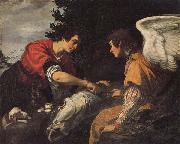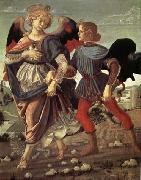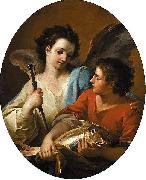Wholesale Oil Painting No Minimum |
|||||||||||
|
|
|||||||||||

|
|||||||||||
|
|
|
||||||||
Antonio Pollaiuolo1431-1498 Italian Antonio Pollaiuolo Galleries Sculptor, painter, designer and engraver. He was trained as a goldsmith and bronze sculptor, probably in Lorenzo Ghiberti workshop. In 1466 he joined the Arte della Seta, the silkworkers guild (to which goldsmiths traditionally belonged), and he listed himself as a goldsmith and painter in the membership records of the Compagnia di S Luca in 1473; this is the only documented reference to him as a painter. In his tax return in 1480 he reported that he was renting a workshop specifically for goldsmiths work. He still described himself as a goldsmith, and not as a painter, in his last tax return in 1496. |
||||||||
|
|
||||||||
Tobias and the Angel
Tobias and the Angel Painting ID:: 1590 |
1460 Galleria Sabuda, Turin 1460 Galleria Sabuda, Turin |
|||||||
|
|
||||||||
Jacopo VignaliItalian painter who died on 03 August 1664 Italian painter. At an early age he entered the studio of Matteo Rosselli in Florence, and his first works, Virgin and Saints (1616; Florence, S Brigida, Santuario della Madonna del Sasso) and the ceiling painting Love of the Fatherland (1616; Florence, Casa Buonarroti), were influenced by Rosselli and Ludovico Cigoli. In 1616 he enrolled at the Accademia del Disegno in Florence, becoming an academician in 1622. In the 1620s he moved away from Rosselli's influence and developed a style distinguished by dramatic light effects, rich colour and painterly technique and by the expression of deep emotion. The decade opened with the Investiture of St Benedict (1620; Florence, Semin. Maggiore), one of a series of works painted in honour of St Benedict for the Confraternit? di S Benedetto Bianco, to which Vignali had belonged since 1614. Having learnt the technique of fresco painting from Rosselli, he also began to work in that medium and was involved in the decoration of the Casa Buonarroti throughout the decade, the ceiling fresco Jacob's Dream dating from 1621. |
||||||||
|
|
||||||||
|
|
Tobias and the Angel
Tobias and the Angel Painting ID:: 28969 |
mk65
Oil on canvas
52 3/8x63 3/8in
mk65 Oil on canvas 52 3/8x63 3/8in |
||||||
|
|
||||||||
|
|
||||||||
|
|
Tobias and the angel
Tobias and the angel Painting ID:: 45535 |
mk186
around 1465 Turin, Galleria Sabauda mk186 around 1465 Turin, Galleria Sabauda |
||||||
|
|
||||||||
Andrea del VerrocchioItalian Early Renaissance Sculptor, ca.1435-1488 Florentine sculptor and painter, whose real name was Andrea di Michele di Francesco di Cioni. He was a leading figure in the early Renaissance, and his workshop was a center for the training of young artists in Florence. A virtuoso metalworker, Verrocchio was primarily concerned with the spirited rendering of movement and the elaboration of detail. Many of his paintings are lost. Of the remaining panels, his hand is evident in the Baptism of Christ (Uffizi), assisted by Leonardo da Vinci. In the Pistoia altarpiece he was aided by Lorenzo di Credi. Other attributions are Tobias and the Angel (National Gall., London), two paintings of the Madonna and Child (National Gall., London; Berlin), and a Crucifixion with Saints (Argiano). Most of Verrocchio's achievements in sculpture have survived. His earlier work includes the bold group Incredulity of St. Thomas (Orsanmichele). In 1472 he designed the tombs of Piero and Giovanni de' Medici (San Lorenzo). In the same period he created the graceful Boy with a Dolphin and a lithe portrayal of David (Bargello). He went to Venice (c.1480) to work on the equestrian monument of the condottiere Bartolomeo Colleoni. |
||||||||
|
|
||||||||
|
|
Tobias and the Angel
Tobias and the Angel Painting ID:: 51772 |
nn09
c.1470-800
33x26in nn09 c.1470-800 33x26in |
||||||
|
|
||||||||
Corrado Giaquinto1703-1766 Italian Corrado Giaquinto Galleries He was born in Molfetta. As a boy he apprenticed with a modest local painter Saverio Porta, (c1667-1725), escaping the religious career his parents had intended for him. By October 1724, he left Molfetta, and along with his contemporaries Francesco de Mura (1696-1784) and Giuseppe Bonito (1707-1789), he trained from 1719-23 in the prolific Neapolitan studio of Francesco Solimena, either with Solimena or his pupil, Nicola Maria Rossi. Throughout his life, Giaquinto was a peripatetic painter, with long sojourns in Naples, Rome (between 1723-53), Turin (1733 and 1735-9), and Madrid (1753-1761). In 1723, he moved to Rome to work in the studio of Sebastiano Conca. He painted in San Lorenzo in Damaso, San Giovanni Calibita, and the ceiling at Santa Croce in Gerusalemme. In March 1727, with Giuseppe Rossi as an assistant, Giaquinto opened an independent studio near the Ponte Sisto, in the parish of Saint Giovanni of the Malva in Rome. In 1734, he married Caterina Silvestri Agate. The first documented work by his hand is Christ crucified with the Madonna, Saint John Evangelist, and Magdalene commissioned in 1730 by king John V of Portugal for the cathedral of the Mafra. In 1731, he received a prestigious commission, to execute frescoes in the church of San Nicola dei Lorenesi: Saint Nicholas water gush from cliff, three theologic and cardinal Virtues, and in the cupola Paradise. The latest restoration confirms Giaquinto stylistic independence from Solimena, and reveals his stylistic dependence on Luca Giordano. |
||||||||
|
|
||||||||
|
|
Tobias and the Angel
Tobias and the Angel Painting ID:: 68384 |
c. 1740
Oil on canvas
58 x 48 cm
c. 1740 Oil on canvas 58 x 48 cm |
||||||
|
|
||||||||
Benedito Calixto(14 October 1853 -- 31 May 1927) was a Brazilian painter. His works usually depicted figures from Brazil and Brazilian culture, including a famous portrait of the bandeirante Domingos Jorge Velho in 1923, and scenes from the coastline of São Paulo. Unlike many artists of the time, Calixto's patron was an individual other than the state, who were "the most dependable source of patronage." |
||||||||
|
|
||||||||
|
|
Tobias and the Angel
Tobias and the Angel Painting ID:: 96691 |
1909(1909)
Medium oil on canvas
Dimensions 311 X 127 cm
cyf 1909(1909) Medium oil on canvas Dimensions 311 X 127 cm cyf |
||||||
|
|
||||||||
|
Benedito Calixto (14 October 1853 -- 31 May 1927) was a Brazilian painter. His works usually depicted figures from Brazil and Brazilian culture, including a famous portrait of the bandeirante Domingos Jorge Velho in 1923, and scenes from the coastline of São Paulo. Unlike many artists of the time, Calixto's patron was an individual other than the state, who were "the most dependable source of patronage." Tobias and the Angel 1909(1909) Medium oil on canvas Dimensions 311 X 127 cm cyf |
||||||||
|
|
||||||||
|
Prev Next
|
||||||||
|
|
||||||||
|
Related Paintings to Benedito Calixto :. |
||||||||
|
|
||||||||
|
CONTACT US |






